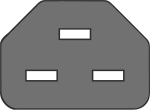"IEC connector" redirects here. For other uses, see IEC connector (disambiguation).
IEC 60320 is a set of standards from the International Electrotechnical Commission (IEC) specifying non-locking appliance and interconnection couplers for connecting power supply cords to electrical appliances up to 250 volts.[1]Appliance couplers enable the use of standard inlets and country-specific cord sets which allow manufacturers to produce the same appliance for many markets, where only the cord set has to be changed for a particular market.Interconnection couplers allow a power supply from a piece of equipment or an appliance to be made available to other equipment or appliances. Couplers described under these standards have standardized current and temperature ratings.
Different types of connector (distinguished by shape and size) are specified for different combinations of current, temperature and earthing requirements. Unlike IEC 60309 connectors, they are not coded for voltage; users must ensure that the voltage rating of the equipment is compatible with the mains supply.
Each type of coupler is identified by a standard sheet number. For appliance couplers this consists of the letter C followed by a number, where the standard sheet for the appliance inlet is 1 higher than the sheet for the corresponding cable connector. Many types of coupler also have common names. The most common ones are IEC connector for the common C13 and C14, the figure of 8 connector for C7 and C8, and cloverleaf connector orMickey Mouse connector for the C5/C6. Kettle plug is a colloquial term used for the high-temperature C16 appliance inlet (and sometimes, wrongly, for the mating C15 female connector). Kettle plug is sometimes, incorrectly, used to refer to regular temperature C13 and C14 connectors.
The first edition of IEC 320 (later renumbered IEC 60320) was published in 1970.[2]
| Connector (Female)[7] | Appliance Inlet (Male)[8] | Diagram | Pin spacing, centres (mm) | Earth contact | Appliance class | Rewirable connector allowed? | Max. current (A) | Max. pin temp. (°C) | Remarks and example uses |
|---|---|---|---|---|---|---|---|---|---|
| C1 | C2 |  | 6.6 | No | II | No | 0.2 | 70 | |
| C3 | C4 | 10 | No | II | 2.5 | 70 | |||
| C5 | C6 |  | 10 (H) 4.5 (V) | Yes | I | No | 2.5 | 70 | |
| C7 | C8 |  | 8.6 | No | II | No | 2.5 | 70 | |
| C9 | C10 |  | 10 | No | II | No | 6 | 70 | |
| C11 | C12 | 10 | No | II | 10 | 70 | |||
| C13 | C14 |  | 14 (H) 4 (V) | Yes | I | Yes | 10 | 70 | |
| C15 | C16 |  | 14 (H) 4 (V) | Yes | I | Yes | 10 | 120 | |
| C15A | C16A |  | 14 (H) 4 (V) | Yes | I | Yes | 10 | 155 | |
| C17 | C18 |  | 14 | No | II | No | 10 | 70 | |
| C19 | C20 |  | 13 (H) 8 (V) | Yes | I | Yes | 16 | 70 | |
| C21 | C22 |  | 13 (H) 8 (V) | Yes | I | Yes | 16 | 155 | |
| C23 | C24 |  | 13 | No | II | No | 16 | 70 |
沒有留言:
張貼留言